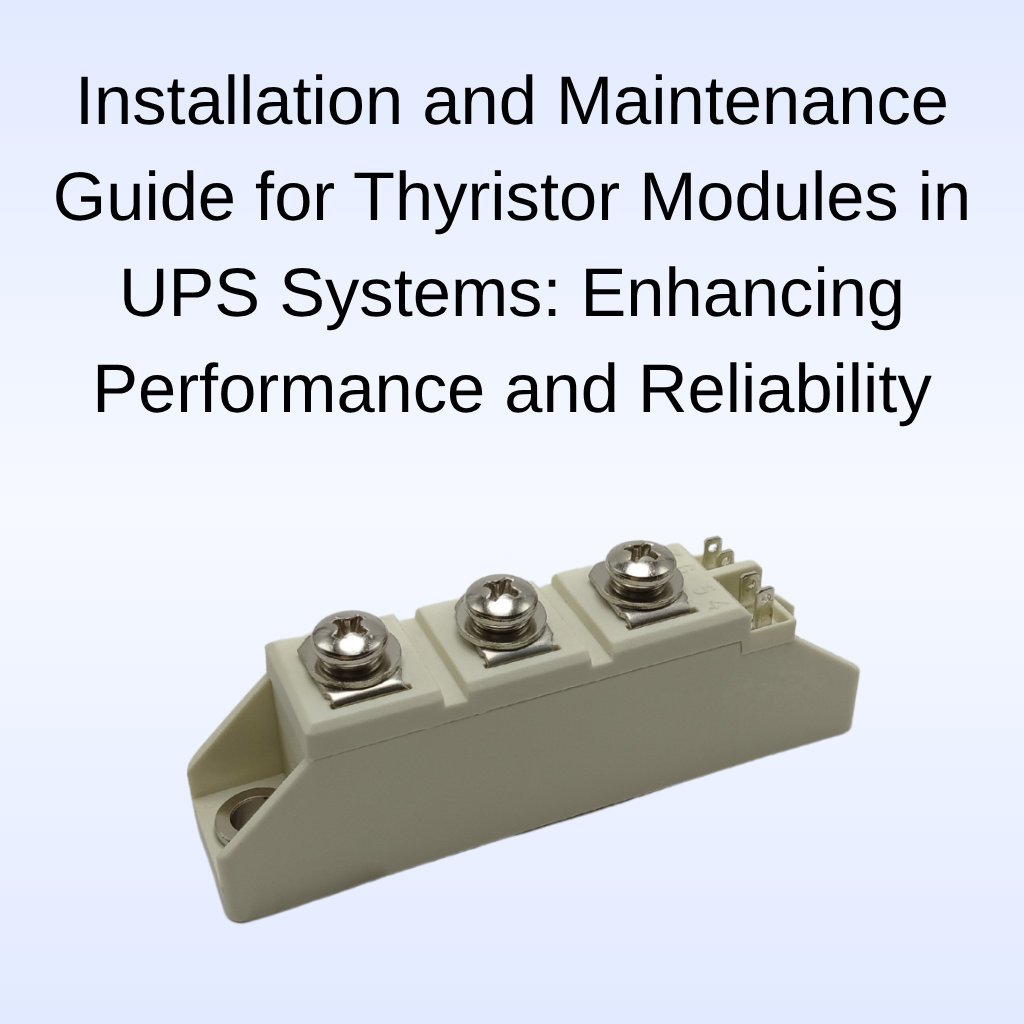Installation and Maintenance Guide for Thyristor Modules in UPS Systems: Enhancing Performance and Reliability
Thyristor modules are key components in Uninterruptible Power Supply (UPS) systems, offering efficient power control and protection for sensitive equipment. Proper installation and ongoing maintenance are critical to ensuring the long-term performance and reliability of the UPS system. This guide covers the installation and maintenance of the dual-SCR series-connected compact 106A thyristor module for UPS systems, 7-terminal light-dimming DC-motor-control 106A thyristor module for UPS systems, and replacement industrial heating high-reliability 106A thyristor module for UPS systems.
Step 1: Installation of Thyristor Modules
Dual-SCR Series-Connected Compact 106A Thyristor Module: The dual-SCR series-connected compact 106A thyristor module for UPS systems is designed for high efficiency and space-saving installation. During installation, ensure that the module is securely connected to the power converter to enable seamless DC to AC conversion. Ensure the module is placed in a well-ventilated area to prevent overheating. Proper ventilation is essential for maintaining optimal performance.
7-Terminal Light-Dimming DC-Motor-Control Thyristor Module: The 7-terminal light-dimming DC-motor-control 106A thyristor module for UPS systems is perfect for applications that require precise motor control or light dimming. Ensure that the wiring is done according to the manufacturer's instructions. The 7-terminal configuration needs to be securely connected to avoid functionality issues during operation.
Replacement Industrial Heating High-Reliability Thyristor Module: The replacement industrial heating high-reliability 106A thyristor module for UPS systems is ideal for use in high-demand environments. It is essential to select the correct module for your UPS system and follow the guidelines for installation. This module is designed to handle high loads and operate reliably in harsh conditions.
Handling Surge Current: These modules must be able to handle high surge current effectively. Proper installation will ensure that the UPS system is equipped to handle power surges, protecting sensitive equipment from damage caused by sudden fluctuations in power.
Step 2: Testing After Installation
Low On-State Voltage Testing: After installation, test the low on-state voltage of the thyristor modules. This helps to minimize energy loss and improve the overall efficiency of the UPS system.
Surge Current Handling: Conduct surge current tests to verify that the modules can handle high surge current without affecting the performance of the system. Proper handling of surge currents is crucial for protecting the UPS system and connected equipment.
Motor Control Testing: For systems with the 7-terminal light-dimming DC-motor-control 106A thyristor module, check the motor control functionality. Verify that the module operates smoothly, adjusting motor speed and dimming light levels precisely without malfunctioning.
Step 3: Maintenance of Thyristor Modules
Routine Inspections: Conduct regular inspections of the thyristor modules to detect any signs of wear, corrosion, or physical damage. Particularly around the dual-SCR series-connected compact 106A thyristor module for UPS systems, overheating can lead to failure if not addressed promptly.
Cleaning and Dust Removal: Dust and debris can accumulate on the thyristor modules, causing a reduction in efficiency. Clean the modules regularly using compressed air or a soft brush to remove dust and ensure proper airflow.
Thermal Management: Proper thermal management is vital to the operation of thyristor modules. Check that the cooling system (fans, heat sinks) is functioning correctly. Overheating can significantly reduce the lifespan of the modules and impact system reliability.
Surge Current Monitoring: Continuously monitor the UPS system for any surge current issues. If frequent surge currents are detected, evaluate whether the modules are within their rated capacity. If necessary, replace the modules to maintain optimal system performance.
Conclusion
Proper installation and ongoing maintenance of thyristor modules are essential to maintaining the efficiency and reliability of UPS systems. By following these installation steps and regularly maintaining the dual-SCR series-connected compact 106A thyristor module for UPS systems, 7-terminal light-dimming DC-motor-control 106A thyristor module for UPS systems, and replacement industrial heating high-reliability 106A thyristor module for UPS systems, you can optimize UPS performance and extend module lifespan. Regular inspections, cleaning, and thermal management will ensure that your UPS system operates efficiently, even under heavy loads or power surges.
READ MORE:
Purchasing and Supply of Thyristor Modules for UPS Systems: Key Factors for UPS Systems
Installation and Maintenance Guide for Thyristor Modules in UPS Systems: Ensuring System Efficiency
Installation and Maintenance Guide for Thyristor Modules in UPS Systems
Installation and Maintenance Guide for Thyristor Modules in UPS Systems: Long-Term Reliability

